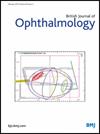伴有或不伴有早产儿视网膜病变的儿童和青少年中斜视、眼球震颤的患病率及危险因素:来自古腾堡早产儿研究的结果
IF 3.5
2区 医学
Q1 OPHTHALMOLOGY
引用次数: 0
摘要
目的本研究以胎龄(GA)、早产儿视网膜病变(ROP)及ROP治疗为分层标准,评估早产儿斜视、眼球震颤的患病率及其危险因素。方法:本研究是一项回顾性队列研究,对4-17岁早产儿和足月儿童进行前瞻性随访。多变量logistic回归分析评估了斜视和眼球震颤与围产期参数的关系。参与者分为以下组:足月出生的对照组(GA≥37周,第1组)、未发生ROP且GA 33-36周的早产儿(第2组)、GA 29-32周(第3组)、GA≤28周(第4组)、GA≤32周且ROP未治疗(第5组)和GA≤32周且ROP治疗(第6组)。结果共纳入患儿949例(11.21±3.92岁),其中女性495例。1组患儿斜视发生率为6%,2组为10%,3组为12%,4组为23%,5组为20%,6组为68%。各组眼球震颤发生率分别为0.8%、0.4%、1.8%、2.6%、5.0%和47%。斜视与早期GA (OR=1.08; p=0.01)、散光(OR=2.48; p=0.02)和远视(OR=2.09; p=0.04)相关。内斜视与早产周数(OR=1.11; p=0.02)、屈光参差(OR=3.09; p=0.02)和远视(OR=4.17; p<0.001)相关。眼球震颤与ROP (OR=7.49; p=0.03)、屈光参差(OR=5.17; p=0.04)和近视(OR=11.09; p<0.001)相关。结论儿童斜视与早产和屈光不正有关,而眼球震颤在ROP和屈光不正儿童中更为普遍。如有合理要求,可提供资料。AF有权查阅所有研究数据,并对数据的完整性和数据分析的准确性负责。以AF和SaG进行统计学分析。本分析提供了一个队列的临床数据。该项目是一项重要的科学工作,具有高方法标准和详细的分析和出版指南,以确保科学分析处于最高水平。因此,在建立和控制的工作流程和算法之外,科学界无法获得数据。为了满足科学发现的验证和再现性的一般想法,我们提供在任何时候应要求访问本地数据库的数据。感兴趣的研究人员可向GPES的协调首席研究员提出请求(achhim fiesass; Achim .fiess{at}unimedizin-mainz.de)。更详细的联系信息可以在美因茨大学医学中心的主页上找到(www.unimedizin-mainz.de)。本文章由计算机程序翻译,如有差异,请以英文原文为准。
Prevalence of strabismus, nystagmus and risk factors in children and adolescents born preterm with and without retinopathy of prematurity: results from the Gutenberg Prematurity Study Young
Aims This study assessed the prevalence of strabismus, nystagmus and their risk factors in children born preterm, stratified by gestational age (GA), retinopathy of prematurity (ROP) and ROP treatment. Methods This is a retrospective cohort study with a prospective follow-up in a large cohort of children born preterm and full-term aged 4–17 years. Multivariable logistic regression analyses assessed associations of strabismus and nystagmus with perinatal parameters. Participants were divided into the following groups: controls born at term (GA ≥37 weeks, group 1), children born preterm without ROP and GA 33–36 weeks (group 2), GA 29–32 weeks (group 3), GA ≤28 weeks (group 4), GA ≤32 weeks with untreated ROP (group 5) and GA ≤32 weeks with treated ROP (group 6). Results 949 children (11.21±3.92 years, 495 females) were included. Strabismus was observed in 6% of children in group 1, 10% in group 2, 12% in group 3, 23% in group 4, 20% in group 5 and 68% in group 6. Nystagmus was observed in 0.8%, 0.4%, 1.8%, 2.6%, 5.0% and 47% in the respective groups. Strabismus was associated with earlier GA (OR=1.08; p=0.01), astigmatism (OR=2.48; p=0.02) and hypermetropia (OR=2.09; p=0.04). Esotropia was associated with weeks of prematurity (OR=1.11; p=0.02), anisometropia (OR=3.09; p=0.02) and hypermetropia (OR=4.17; p<0.001). Nystagmus was associated with ROP (OR=7.49; p=0.03), anisometropia (OR=5.17; p=0.04) and myopia (OR=11.09; p<0.001). Conclusions Strabismus in children is linked to preterm birth and refractive error, while nystagmus is more prevalent in children with ROP and children with refractive errors. Data are available upon reasonable request. AF had full access to all study data and takes responsibility for the integrity of the data and the accuracy of the data analysis. Statistical analyses were performed by AF and SaG. The analysis presents clinical data of a cohort. This project constitutes a major scientific effort with high methodological standards and detailed guidelines for analysis and publication to ensure scientific analyses are on the highest level. Therefore, data are not made available for the scientific community outside the established and controlled workflows and algorithms. To meet the general idea of verification and reproducibility of scientific findings, we offer access to data at the local database upon request at any time. Interested researchers may make their requests to the coordinating principal investigator of the GPES (Achim Fieß; achim.fiess{at}unimedizin-mainz.de). More detailed contact information is available at the homepages of the University Medical Center Mainz (www.unimedizin-mainz.de).
求助全文
通过发布文献求助,成功后即可免费获取论文全文。
去求助
来源期刊
CiteScore
10.30
自引率
2.40%
发文量
213
审稿时长
3-6 weeks
期刊介绍:
The British Journal of Ophthalmology (BJO) is an international peer-reviewed journal for ophthalmologists and visual science specialists. BJO publishes clinical investigations, clinical observations, and clinically relevant laboratory investigations related to ophthalmology. It also provides major reviews and also publishes manuscripts covering regional issues in a global context.

 求助内容:
求助内容: 应助结果提醒方式:
应助结果提醒方式:


